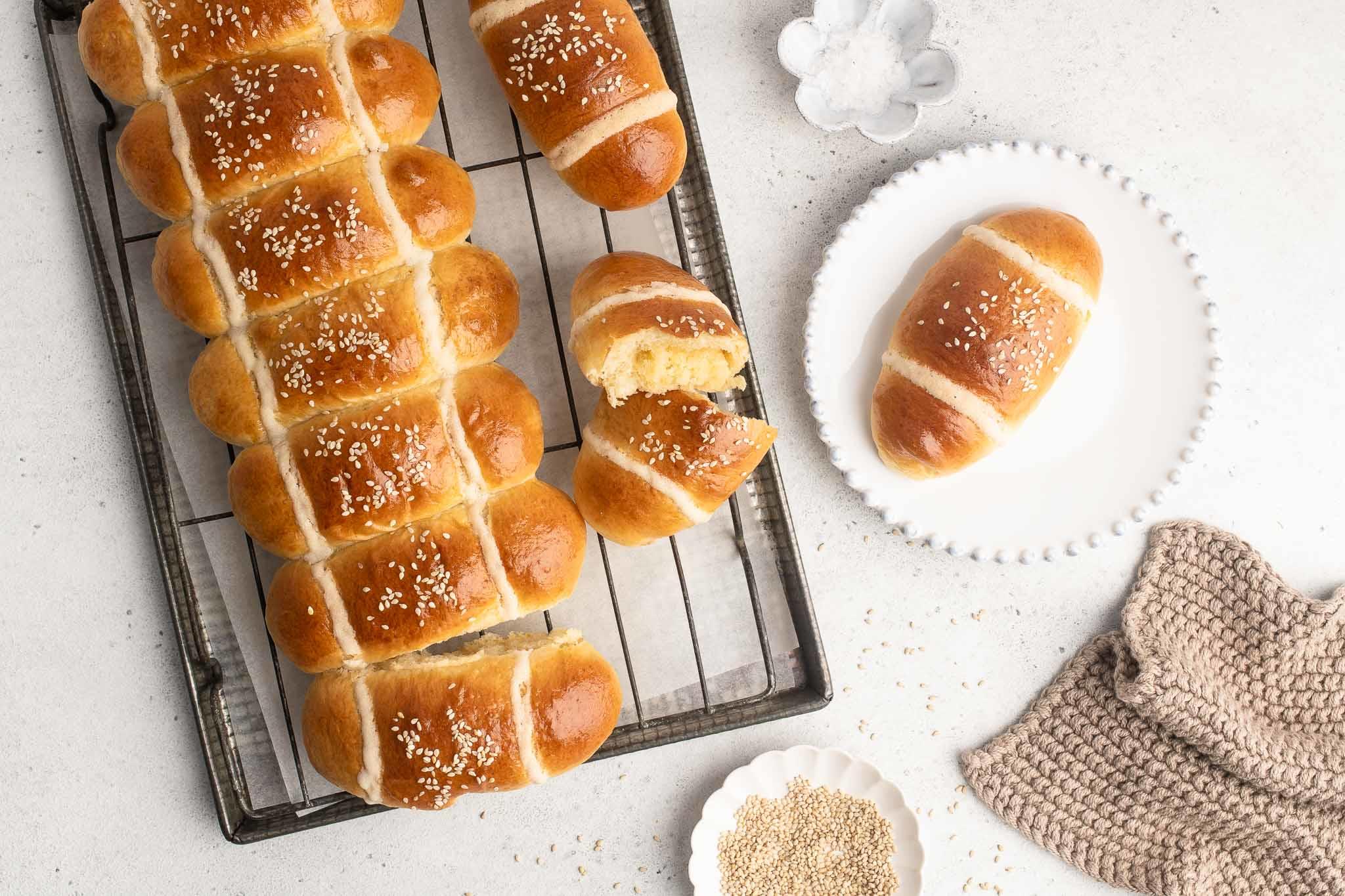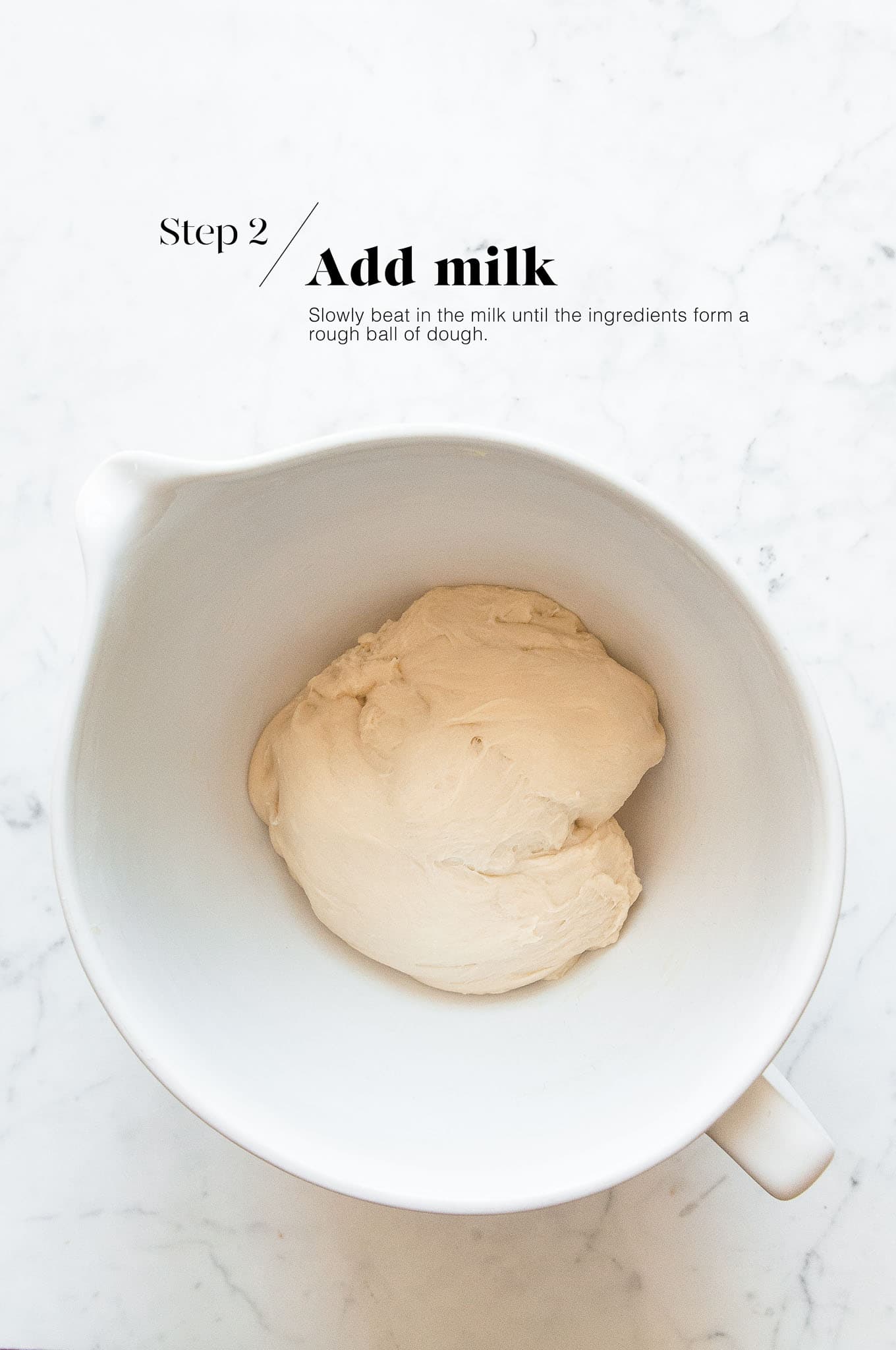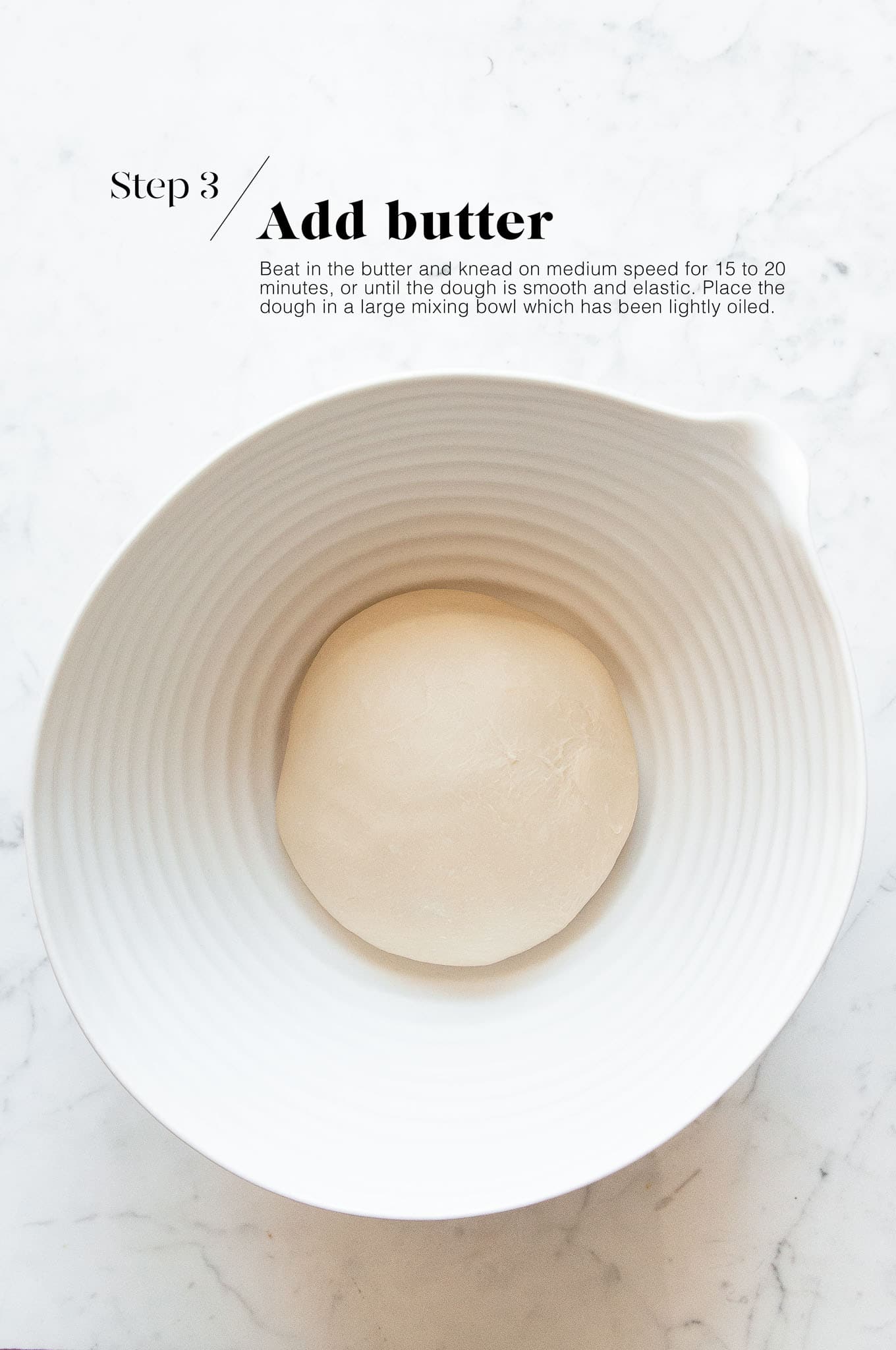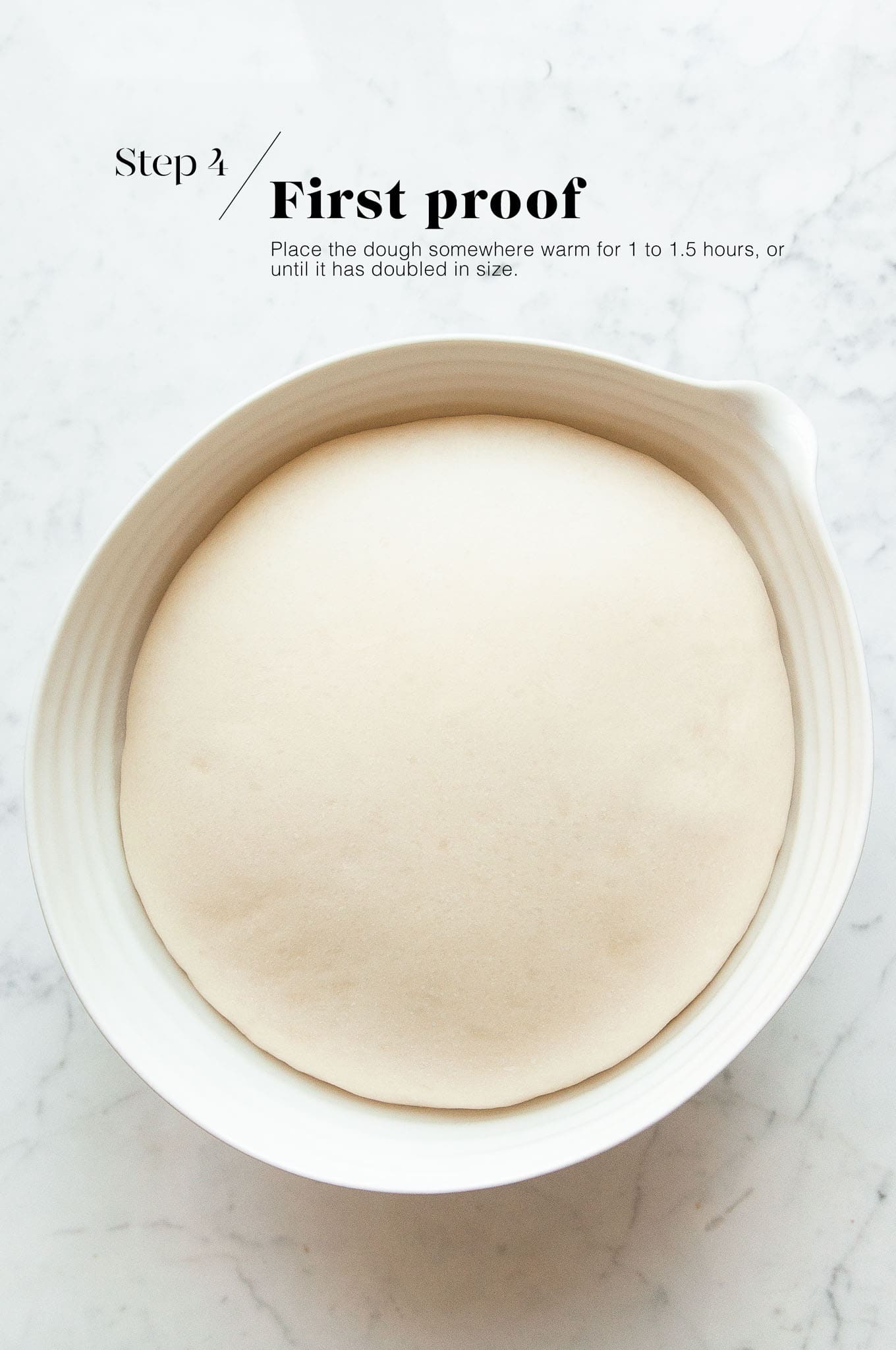Fluffy and delicious Chinese Coconut Buns, just like from the Chinese bakery, except they are better! Recipe with step-by-step photos.

Chinese Coconut Buns
As a child, my parents owned a Vietnamese bakery in Australia. They sold everything from Vietnamese baguettes to Aussie Meat Pies. And despite the vast array of delicious treats on offer, it didn’t stop us from visiting other bakeries and getting our sweet fix elsewhere.
One case in point was the Chinese bakery at the local Chinatown in Brisbane, which became a regular stop for my mother and I after each Yum Cha feast on Sunday morning. Even if we had stuffed ourselves silly with endless dumplings and squeezed in a plate of Chinese Custard Tarts to finish, we still somehow had appetite for more dessert from the Chinese bakery next door.
It was one of those Hong Kong-style bakeries where you grabbed a tray at the entrance and helped yourself to the many cakes and buns on offer. And something I always looked out for were these Chinese Coconut Buns.

What are Chinese Coconut Buns?
Chinese Coconut Buns are a small yeasted bun filled with a sweet coconut filling. Due to their size, they are sometimes called Cocktail Buns.
Chinese Coconut Bun Recipe
The bun itself is used for many other types of baked buns in Chinese baking, and which many recipes refer to as a “milk dough“, due to the use of milk.
Despite this recipe being Chinese in origin, when testing recipes for Chinese Coconut Buns, I found that many of the dough recipes had similarities to French brioche, which is also a yeasted dough enriched with butter, milk and eggs. However, Chinese baked buns are usually not as rich as French brioche.
So I decided to use my trusty recipe for enriched dough (which I use for Finger Buns and Cream Buns) but with the addition of an egg for extra richness and more colour, and which is exactly the same dough that I use for my Cinnamon Rolls.
To this dough, I added a coconut filling and decorative topping which are adapted from The Woks of Life, and the results are perfectly-tasting Chinese Coconut Buns, better than from the Chinese bakery!
So this recipe for Chinese Coconut Buns uses the same dough as for my Cinnamon Rolls, but with a Chinese twist 
Homemade Coconut Buns
I will admit that making these Coconut Buns at home are a bit fiddly and time-consuming. But if you are someone who makes Cinnamon Rolls or Finger Buns, the steps involved here are not too dissimilar.
In any event, if you are like me and live in a city (or country!) that does not have a Chinatown, these Chinese Coconut Buns are a lovely treat, and also a delicious weekend project.
To make Chinese Coconut Buns, you will need to make:
- An enriched dough – this recipe uses a yeasted dough which has been enriched with eggs, milk and butter. Asians refer to it as a “milk dough” or “milk bun” and it has a very similar taste and texture to a French brioche, although not as rich.
- The coconut filling – this is a buttery paste made with dessicated coconut and milk powder. It should be sweet, but not too sweet, with a touch of salt to balance the sweetness.
- The decorative topping – this is essentially a buttery paste which is piped onto the buns. Is it just me or do these buns look like rugby balls?

How to Make Chinese Coconut Buns
Step 1
Measure the flour, sugar, yeast and salt into the bowl of an electric stand mixer. Lightly mix the ingredients together.

Step 2
Add the egg to the bowl. Slowly add the warm milk (you may not need all of it), and lightly beat everything with the dough hook until it comes together into a large ball of dough. Only add as much milk as you need to bring the ingredients together into a dough.

Step 3
Slowly incorporate the butter, one tablespoon at a time, until all of the butter has been used.
Then increase the speed to medium and continue kneading with the dough hook for 15 to 20 minutes, or until the dough is smooth and elastic.

Step 4
Lightly oil a large mixing bowl, and place the dough into the bowl. Cover the bowl with a clean tea towel and leave it somewhere warm for 1 to 1.5 hours, or until the dough has doubled in size.

Step 5
While the dough is proofing, make the Coconut Filling. Place all of the ingredients into a large bowl and beat until everything is combined and smooth. I like to make the filling with my electric stand mixer, but you can also use a wooden spoon.
Step 6
Portion the Coconut Filling into 16 equal pieces. I like to do this using a digital scale (weigh the whole amount of the filling, divide this number by 16 to obtain the weight for each piece).
Roll each piece into a log, about 8 cm/3 inches long.
Step 7
Once the dough is ready, punch it back and knead the dough a few times until it is smooth again. Portion the dough into 16 equal pieces. Again, I like to use a digital scale for this step.
Roll each piece of dough into a ball, and place it on a large baking sheet lined with baking paper. Set the dough aside for about 10 minutes to puff up slightly.
Step 8
Gently roll out a piece of dough to flatten it into a rough oval shape, about 12 cm/5 inches long. Place a piece of Coconut Filling inside the dough. Enclose the filling inside the dough by pinching together the edges of the dough. Shape the dough into an oval shape, and place it on another large baking sheet lined with baking paper.
Repeat the above steps with the remaining pieces of dough.
Step 9
Place the shaped buns onto a large baking sheet lined with baking paper.
If you wish to create individual buns, space the pieces of dough a good 5 cm/2 inches apart. This is the more traditional way to bake the Chinese Coconut Buns.
If you wish to create adjoining buns, place the pieces of dough closer together (about 1 cm/1/2 inch apart). I find that baking the buns closer together creates buns with more height, and with a softer and fluffier interior.
Set the tray aside somewhere warm for about 30 minutes for the buns to rise again.
Step 10
Make the decorative topping by beating together the ingredients in a small mixing bowl until the butter has softened and you have a smooth paste. The butter needs to be quite soft because you will be using a piping bag to pipe the mixture later.
Transfer the paste to a small piping bag, or a small plastic bag with the end snipped off. I like to create lines which are about 5 mm thick.
Step 11
Gently brush the buns with egg wash. Pipe two rows of the decorative topping on each bun. Sprinkle some sesame seeds in the middle of each bun.
Step 12
Bake the buns in an oven at 180°C/350°F for 15-20 minutes, or until they are golden brown. I recommend checking the buns at about 10-15 minutes. If the buns are browning too quickly, place a sheet of foil over them for the rest of the baking time.
Remove the cooked buns to a wire rack to cool completely.
How to Store Coconut Buns
These Chinese Coconut Buns are best eaten the same day they are baked. However, I find they keep very well in a ziplock freezer bag for 2-3 days, away from direct sunlight; the plastic bag will help to keep them soft.

More Bread Recipes
If you are looking for more bread recipes, you might also like:
PrintChinese Coconut Buns

- Resting Time: 1 hour 40 mins
- Author: Thanh | Eat, Little Bird
- Prep Time: 1 hour
- Cook Time: 20 mins
- Total Time: 1 hour 20 minutes
- Yield: Makes 16 buns
- Category: Bread
- Method: Oven
- Cuisine: Chinese
Fluffy and delicious Chinese Coconut Buns, just like from the Chinese bakery, except they are better! Recipe with step-by-step photos.
Ingredients
For the Dough
- 400 g (2 2/3 cup) strong white bread flour
- 75 g (1/3 cup) caster sugar
- 1/2 teaspoon fine salt
- 9 g instant dried yeast (see Kitchen Notes below)
- 1 egg, at room temperature
- 250 ml (1 cup) milk, warmed to 37°C/98°F
- 40 g (2 tablespoons) unsalted butter, softened
For the Coconut Filling
- 170 g (1 1/2 sticks) unsalted butter, softened
- 6 tablespoons caster sugar
- 1/2 teaspoon fine salt
- 6 tablespoons plain flour (all-purpose flour) or cake flour
- 60 g (1/2 cup) skim milk powder
- 80 g (1 cup) dessicated coconut
For the Decorative Topping
- 3 tablespoons unsalted butter, softened
- 50 g (1/3 cup) plain flour (all-purpose flour) or cake flour
- 5 tablespoons caster sugar
For the Egg Wash
- 1 egg
- dash of milk
To Decorate
Instructions
For the Dough
(You will need approx. 3.5 hours to make the Chinese Coconut Buns)
- Measure the flour, sugar, salt and yeast into the bowl of an electric stand mixer.
- Lightly mix the ingredients together using the dough hook.
- Add the egg to the bowl.
- Slowly pour in the warm milk, and continue mixing until everything comes together into a rough dough.
- Add the butter, one tablespoon at a time. Once the butter has been fully incorporated into the dough, add the next tablespoon of butter.
- Once all of the butter has been added, continue kneading the dough on medium speed for about 15 to 20 minutes.
- The dough is ready when it is soft and smooth, and no longer sticks to the side of the bowl. The dough will be somewhat sticky from the butter and egg.
- Lightly oil a large mixing bowl.
- Place the dough inside the bowl.
- Cover the dough with a clean tea towel, plastic wrap, or a reusable bowl cover.
- Leave the dough somewhere warm for 1 to 1.5 hours, or until the dough has doubled in size (see Kitchen Notes below).
- During this time, make the Coconut Filling.
For the Coconut Filling
- Just before the dough is ready, make the filling.
- Place all of the ingredients into the bowl of an electric stand mixer, fitted with a paddle attachment (alternatively, you can do this by hand with a wooden spoon).
- Beat the ingredients together until everything is well combined.
- Portion the filling into 16 equal pieces. If you have some kitchen scales, weigh the filling and then divide this number by 16. This will be the weight of each piece of filling.
- Roll each piece of filling into a log about 8 cm/3 inches long.
To Portion the Chinese Coconut Buns
- Line a 40 x 30 cm/16 x 12 inch sheet pan with baking paper.
- Once the dough has doubled in size, punch back the dough to release all of the air.
- Gently knead the dough a few times.
- Portion the dough into 16 equal pieces. If you have some kitchen scales, weigh the dough and then divide this number by 16. This will be the weight of each bun dough.
- Roll each piece of dough into a round ball. I do this by pulling the edges of the dough together into a tight ball.
- Arrange the balls of dough on the sheet pan.
- Set the balls of dough aside to rest for about 10 minutes, until they are slightly puffy.
To Assemble the Chinese Coconut Buns
- Line a second 40 x 30 cm/16 x 12 inch sheet pan with baking paper.
- Gently roll out a piece of dough with a small rolling pin, until you have a slightly oval shape, about 12 cm/5 inches in length.
- Place a piece of filling in the middle of the dough.
- Encase the filling inside the dough by pinching together the edges of the dough, and shaping the dough into a nice oval shape.
- Place the assembled bun onto the sheet pan with the seam-side down.
- Repeat the above steps with the remaining pieces of dough.
- If you wish to create individual buns, space the pieces of dough a good 5 cm/2 inches apart. This is the more traditional way to bake the Chinese Coconut Buns.
- If you wish to create adjoining buns, place the pieces of dough closer together (about 1 cm/1/2 inch apart). I find that baking the buns closer together creates buns with more height, and with a softer and fluffier interior.
- Place the pan somewhere warm for about 30 minutes, or until the buns have risen and puffed up slightly.
- During this time, make the egg wash and topping.
To Make the Decorative Topping
- Beat all of the ingredients together until you have a thick, but soft, paste.
- Transfer the paste to a small piping bag.
- Cut a small piece off the end of the piping bag.
To Bake the Chinese Coconut Buns
- Preheat the oven to 180°C/350°F (without fan) with a metal baking tray on the middle shelf.
- Gently brush each bun with some egg wash.
- Pipe a line of the topping across the top and bottom of each bun.
- Sprinkle some sesame seeds in the middle of each bun.
- Place the pan of buns on the preheated baking tray.
- Bake the buns for 15 to 20 minutes.
- Check the buns at about 10 minutes, and if they are browning too quickly, cover them with a loose sheet of foil for the rest of the baking time.
- The buns are cooked if an internal thermometer reads 85°C/185°F.
- Gently remove the buns to a wire rack, and leave them to cool completely.
Kitchen Notes
 DIFFERENT TYPES OF FLOUR
DIFFERENT TYPES OF FLOUR
For Swiss Readers:
* I use Zopfmehl (or farine pour tresse) when making bread and enriched dough.
* For cake flour, I use this Backmehl from Betty Bossi which you can buy at Coop.
 DIFFERENT TYPES OF YEAST
DIFFERENT TYPES OF YEAST
* Please note that there is a difference between instant yeast (also called instant dried yeast or fast-action dried yeast) and dried yeast (also called active dry yeast). If you are not sure what type of yeast you have, please check the packaging for instructions on how to use the yeast.
* With instant yeast, you can add it directly to the flour mixture without having to activate it first.
* With dried yeast, you will need to activate it first (usually in some warm liquid).
 PROOFING THE DOUGH
PROOFING THE DOUGH
Dough needs a warm environment for the yeast to activate and cause the dough to rise. If you don’t have a warm place in your home, try one of the following ideas:
* In the oven with the oven light switched on (works only for some ovens).
* In the oven with a tray of boiling water on the bottom shelf.
* In the oven or a steamer oven at a low temperature of about 25-40°C (77-104°F).
 RECIPE CREDIT
RECIPE CREDIT
The recipe for the coconut filling and decorative topping are adapted from The Woks of Life.
 OVEN TEMPERATURES
OVEN TEMPERATURES
All recipes on this website state temperatures for a regular oven (i.e. a conventional oven without fan). If you have a convection oven with a fan, please consult the manufacturer’s handbook on how to adjust the temperature and baking time accordingly.
 CONVERSIONS
CONVERSIONS
To convert from cups to grams, and vice-versa, please see this handy Conversion Chart for Basic Ingredients.
The post Chinese Coconut Buns appeared first on Eat, Little Bird.

 Print
Print Pin Recipe
Pin Recipe Rate
Rate